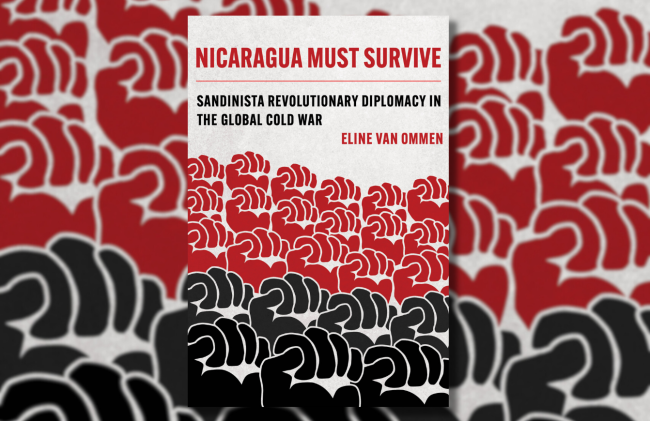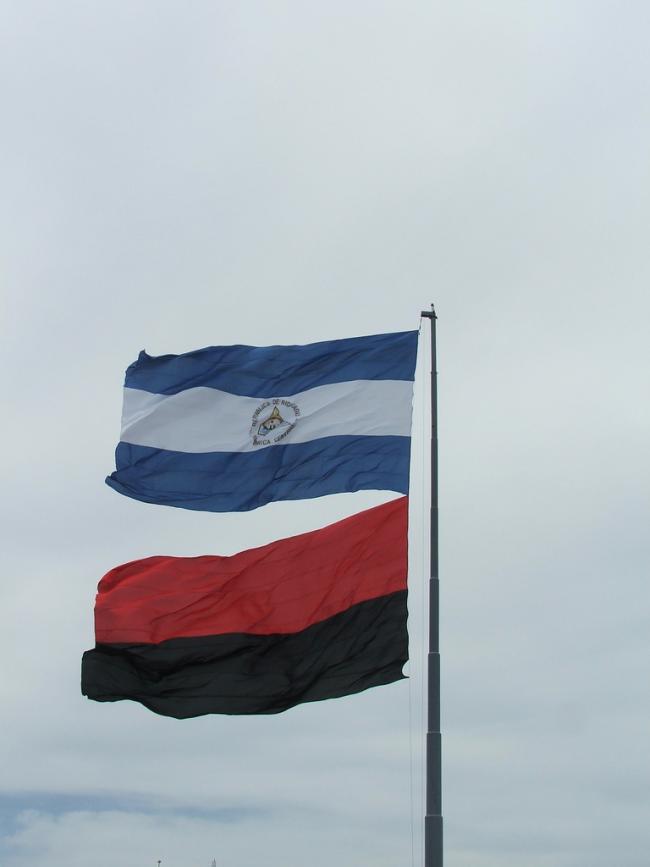
It seems nearly impossible to escape revisionism in Nicaragua these days. Today’s Frente Sandinista de Liberación Nacional (FSLN) bears little resemblance to the jubilant bunch who filled Managua’s main plaza on July 20, 1979. The government’s 2018 repression of young people who evoked Susan Meiselas’s iconic “Molotov Man” cast a long shadow over the past and the present. History and historical memory are contentious. Even conducting archival research is daunting, lately. Yet Eline van Ommen’s Nicaragua Must Survive: Sandinista Revolutionary Diplomacy in the Global Cold War is a well-researched and nuanced analysis of Sandinista international relations’, many what-ifs and if-onlys ago.
Across six engaging chapters and several continents, van Ommen explains how “the FSLN’s revolutionary diplomacy creatively constructed opportunities to benefit the revolution’s survival and reshape international affairs” largely by “shift[ing] the inter-American balance of power in their favor” through the FSLN’s outreach to Western Europe. The point is how international relationships—defined by both grassroots actors and traditional state diplomacy—conditioned how the United States and European Community (EC) were able to respond to the Sandinistas. The implications are significant. Might the FSLN’s elaborate and multi-faceted diplomatic efforts have been the key to the revolution’s longevity and resilience? Nicaragua Must Survive builds toward a refreshingly careful “it is difficult to say.”
Chronological chapters begin in 1977 just two years before the Sandinistas’ victory and end in 1990 with their electoral defeat. The first chapter traces the expansion of the FSLN’s pragmatic revolutionary diplomacy as it courted support across the political spectrum. The second chapter explains how the FSLN adapted its foreign policy once in power, realizing its revolutionary program and reshaping the state’s diplomatic corps. Relations with Western European solidarity activists became estranged as their priorities diverged. Chapter 3 addresses how the Sandinistas sought a defensive balance after Ronald Reagan’s election to the US presidency. Chapter 4 details how cultural diplomacy grew in importance as the regional balance of power and political violence shifted in 1983 and 1984. Chapter 5 explains the 1985 fundraising campaign Nicaragua Debe Sobrevivir (which gives the book its title). This was a uniquely centralized campaign focused on the economic stability that proved elusive to the FSLN government faced with trade embargos, structural adjustment packages, the expense of the Contra war, and its own ambitious social reforms and infrastructure projects. Finally, the last chapter explains how the FSLN’s participation in the Central American peace processes weakened its regional political position and led to its electoral loss. Van Ommen carried out research in government and social movement organization archives in Nicaragua, Germany, The Netherlands, the United Kingdom, United States, and Cuba. She also made excellent use of private collections and oral history interviews. Clearly, van Ommen’s archival research is impressive.
In addition to being expertly researched in at least four languages and across many archives, Nicaragua Must Survive accomplishes the challenging task of contextualizing and explaining the policy actions of many different nations, administrations, and organizations. In this task, Van Ommen’s clear writing goes a long way. She avoids unnecessary acronyms and explains any necessary ones. Her chapter summaries and sections offer an effective map of chronological and thematic areas of focus. The book also nicely highlights tensions within the solidarity movement, especially the unequal power dynamics, contentious motives, and practical limitations that conditioned what it could achieve. The second chapter’s analysis of the disjunctures between Sandinistas and Western European solidarity activists reminds us how such efforts can replicate hierarchical global power relationships and even collapse when those hierarchies are challenged. Its claim that Central American efforts to garner Western European solidarity contributed to Western Europe’s revival as a power bloc independent from the United States was also fascinating.

This is a book written primarily for scholarly audiences. It is in conversation with much of the tidal wave of scholarship about Latin America’s Cold War since the early 2000s inspired by Odd Arne Westad, Gilbert Joseph, Daniela Spenser, and Greg Grandin, among others. It resonates with Jeremi Suri’s claim about the 1960-1975 period of the Cold War when “pressures for internal competition enabled domestic contention.” Yet van Ommen looks beyond the inter-American system, shifting her frame of analysis to a Euro-American Cold War. Other obvious audiences for this book are researchers and scholars of diplomacy and social movements. Historians of grassroots activism in the vein of Alison Bruey, Molly Todd, Susan Bibler Coutin, Jessica Stites-Mohr, and James Green will also find much of interest here. The second chapter’s discussion of the tensions that arose between Sandinistas and solidarity activists adds valuable context to the famous 1980 Literacy Crusade. Throughout, carefully chosen posters and photographs illustrate how the revolution was envisioned abroad and, in several special cases, the excitement of revolutionary youth involved in solidarity work.
Van Ommen asserts the need for historical scholarship on Cold War Latin America beyond the inter-American system. For one, the FSLN’s international efforts were not only focused on the United States, but were global. Second, she argues that a focus on the inter-American system reinforces parochial understandings of Central America. Third, taking a broad view geographically shows how “it was Latin America and not the United States that ‘won the wider war of ideas,’” van Ommen writes, invoking recent arguments by historian Mateo Jarquín. These claims ring true. Indeed, recent research by historians such as Quinn Slobodian, Eric Zolov, Kirsten Weld, Daniel Fernández, and Stella Krepp, to name but a few, has expanded our understanding of Latin American-European relations during the Cold War. This book is a welcome addition to those analyses. But relations between Latin America and the world beyond Europe and the United States remain largely untouched.
Considering a Global History of the FSLN and Ortega's Nicaragua
The FSLN’s global history—not just that of its relations with the inter-American system or the European Community (EC)—awaits another book. Nicaragua Must Survive makes the case for just such scholarship. How did the FSLN, like revolutionary Cuba, the Farabundo Martí National Liberation Movement (FMLN), the Tupamaros, Brazil’s Landless Workers Movement (MST), and other groups forge relationships with allies in the Global South outside of the Americas? Recent historical scholarship has begun to ask these questions, recovering crucial but often forgotten relations among progressive forces across the Global South.
Other limitations of the book also nicely point toward future research. By and large, this is a book about political elites. Campesinos and working class people who stood to gain from some of the revolution’s most compelling promises—land, literacy, and health—are not part of this story. In fact, these promises appear largely as diplomatic game pieces rather than life-altering avenues to political participation and quality of life. Notably, in chapters 3, 4, and 5, the book argues that internal projects like the literacy campaign and health efforts came at the expense of external diplomatic efforts and vice versa. Full appreciation of the effects of this zero-sum equation should come with more discussion of domestic policies themselves. Another direction that could only enrich this book’s terrific analysis is a history of opposition party president Violeta Chamorro’s diplomatic relations and the grassroots activism that supported her post-Sandinista administration.
Unlike the Sandinistas whose efforts van Ommen carefully details in Nicaragua Must Survive, the current President of Nicaragua Daniel Ortega has pursued a policy of isolation as of late. In January 2023, Ortega skipped the annual meeting of the Community of Latin American and Caribbean States (CELAC), after none of its thirty-three member countries supported the Ortega-Murillo regime. Prominent members of the Latin American Left have signed letters and given speeches about the regime’s repression of free speech, neoliberal economic policies, and corruption. In April 2022, Nicaragua withdrew from the Organization of American States (withdrawal was completed in November 2023). The regime’s diplomatic relations outside of the region are equally strained as the emotional bonds of nostalgia weaken. Later in 2022, the Ortega government expelled the European Union ambassador, severed ties with the Netherlands after it rescinded funding for a hospital, and refused to acknowledge the new U.S. ambassador. The Vatican also closed its embassy in Nicaragua. As its European allies dwindle, Nicaragua has looked to China and Russia. Van Ommen’s work helps us (and historians of the future) make sense of these meaningful shifts.
Heather Vrana is Associate Professor of Modern Latin American History at the University of Florida.

